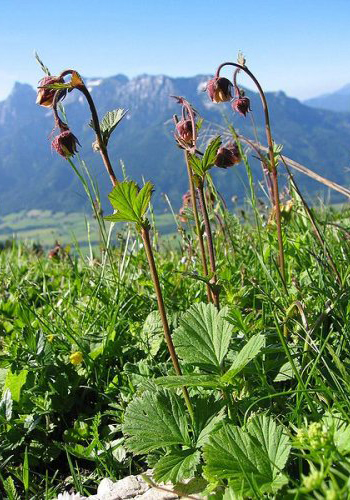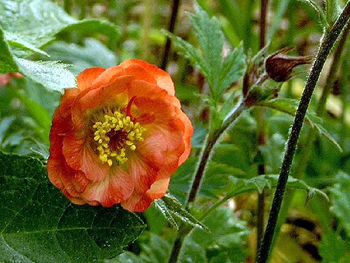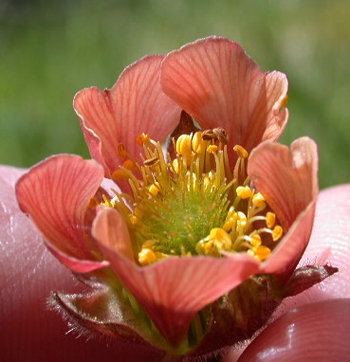Contents:
Common Names | Parts Usually Used | Plant(s) & Culture | Where Found | Medicinal Properties
Legends, Myths and Stories | Uses | Formulas or Dosages | Nutrient Content | How Sold | Warning | Bibliography
Scientific Names

- Geum rivale L.
- Rose family
Common Names
- Avens root
- Chocolate root
- Cure all
- Indian chocolate
- Purple avens
- Throat root
Parts Usually Used
Root, dried
Back to Top
Description of Plant(s) and Culture

Water avens is a hairy perennial plant; its woody rootstock produces a simple, erect stem from 1-3 feet high with small, sessile, simple or three-cleft leaves. From the rootstock also grow long-petioled, hairy, pinnate leaves with three large terminal, coarsely double-toothed leaflets and one or two pairs of small lower leaflets. At the top of the stem grow from 3-5 purplish flowers on short pedicels, blooming from May to July. Some varieties have purplish sepals but rose-colored to yellow petals. Blossoms are followed by hooked fruits.
Another variety: Rough avens (Geum virginianum) and G. japonicum, both used medicinally like water avens.
Back to Top
Where Found
Found mostly in moist and wet places from Colorado and New Mexico northeastward, and in Canada, Europe and Asia.
Back to Top
Medicinal Properties
Astringent, stomachic, tonic
Back to Top
Legends, Myths and Stories

The amateur giving this plant a cursory glance would not associate it with other plants in the rose family. The dull reddish, nodding flowers characterize the plant.
Water avens was once used as a cocoa substitute.
Back to Top
Uses
The rootstock makes a tasty and effective remedy for diarrhea and dysentery when taken with milk and sugar. It also acts to improve appetite and digestion, dyspepsia. An infusion made from the whole plant can be used to clear up respiratory congestion and to counteract nausea.
Powdered root was once used as astringent for hemorrhage, fevers, and leukorrhea.
Back to Top
Formulas or Dosages
Infusion: steep 1 tsp. rootstock in 1 cup water for 30 minutes. Take 1/2 cup before going to bed, or a mouthful 3 times a day. Take no more than 2 cups in total consecutive doses.
Infusion: steep 1 or 2 tsp. fresh plant in 1 cup water. Take 1 cup a day.
Tincture: a dose is from 10-20 drops.
Back to Top
Warning
Excessive amounts can produce unpleasant side effects.
Back to Top
Bibliography
![]() The Herb Book
The Herb Book, by John Lust, Bantam Books, 666 Fifth Avenue, New York, NY. copyright 1974.
![]() Eastern/Central Medicinal Plants
Eastern/Central Medicinal Plants, by Steven Foster and James A. Duke., Houghton Mifflin Company, 215 Park Avenue South, New York, NY 10000
Herbal Gardening, compiled by The Robison York State Herb Garden, Cornell Plantations, Matthaei Botanical Gardens of the University of Michigan, University of California Botanical Garden, Berkeley., Pantheon Books, Knopf Publishing Group, New York, 1994, first edition
![]() American Folk Medicine
American Folk Medicine, by Clarence Meyer, Meyerbooks, publisher, PO Box 427, Glenwood, Illinois 60425, 1973
![]() Webster’s New World Dictionary
Webster’s New World Dictionary, Third College Edition, Victoria Neufeldt, Editor in Chief, New World Dictionaries: A Division of Simon & Schuster, Inc., 15 Columbus Circle, New York, NY 10023
 An Instant Guide to Medicinal Plants
An Instant Guide to Medicinal Plants, by Pamela Forey and Ruth Lindsay, Crescent Books (January 27, 1992).
